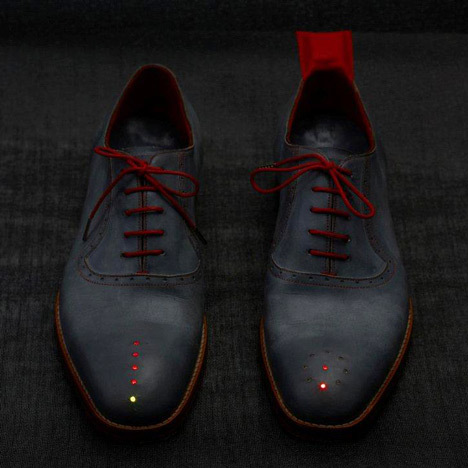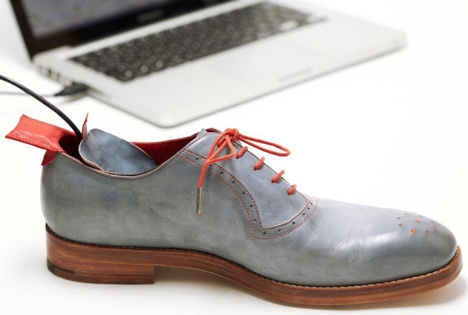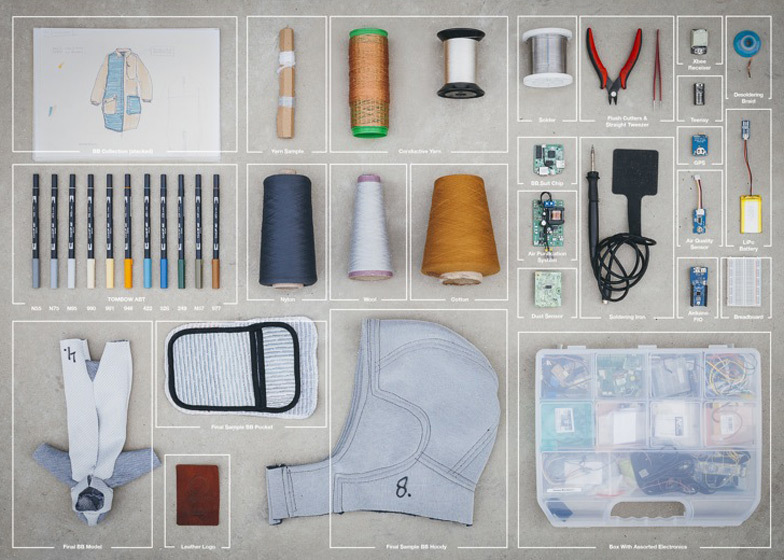User:Mimi
Q 9
Internal link: b.v: user:blabla of Main_page
pagina naam ontdekken? Achter het schuine streepje in de link staat de naam vermeld.
[ enkel
external link:
[[ dubbel
Youtube is also external link.
| = een streepje dat ervoor zorgt dat de text wel kan verschijnen in een internal link.
Bij een external link moet je gewon een spatie doen.
test pagina maken:
main_page/page_that_doesnt_exist
sub pagina:
Contents
Unravel the code introduction WIKI 2016/2017
smaller heading
heading without line
vier?
andere naam geven aan een pagina:
blablabjafahsfk
19/09/16
EXAMPLES RADIATION IN FASHION
Dominic Wilcox
'No place like home' GPS shoes
These shoes are designed by Dominic Wilcox. He worked with LEDs in the toes that will guide you home no matter where you are. One of the No Place Like Home shoes has GPS technology embedded in the heel and an antenna in the red ankle tag. It communicates wirelessly with the other shoe. Custom-made software plots the location of home on a map before the data is uploaded to the shoe through a USB cable that plugs into the insole. The ring of LEDs in the left toe points the wearer in the right direction while those on the right toe show the journey's progress. "I had done a doodle about a month previously on my 'Sounds of Making in East London' record cover of a shoe with a switch on the front," Wilcox told Dezeen. "I think this was in my mind somehow, but I also thought about the Wizard of Oz and Dorothy's shoes to take her home. Mostly it was just an idea for a pair of shoes that I wanted to own myself," he added. Dorothy's red shoes are referenced in the red calf-leather lining, while Wilcox's illustrations of different homes are etched on the soles. Wilcox worked with technology expert Becky Stewart from Codasign and Northampton shoe makers Stamp Shoes. The project was commissioned by the Global Footprint project in Northamptonshire, an English county famous for shoe making. The shoes are being shown at Wilcox's solo exhibition during the London Design Festival.
.
BB SUIT
Dutch designer team: Borre Akkersdijk, Eva de Laat, Martijn ten Bohmer, Daan Spangenberg graphics.
Designed by Borre Akkersdijk, a Dutch textile developer, this prototype is basically the
opposite of the Jammer Coat because it is embedded with copper wires that enable WiFi, GPS, NFC and Bluetooth
that will turn you into a mappable hotspot with MP3 streaming capabilities. All those wires won’t hurt though
as there are two layers of cotton to protect the copper wires inside, thus making it comfortable to wear.
Interesting articles:
Digital and analogue signals
Electromagnetic radiation is used for communications and transmission of information. The waves that are used in this way are radio waves, microwaves, infrared radiation and light.
The idea of using a signal lamp to communicate was used in the 19th century. This method of long distance communication needed a code. One code used was Morse code, a series of long and short flashes of light for different letters of the alphabet. These signals can only be seen when visibility is good and for short distances.
Today we still use codes to send signals using electromagnetic radiation. There are two types of signal, analogue and digital. An analogue signal changes in frequency and amplitude all the time in a way that matches the changes in the voice or music being transmitted. A digital signal has just two values – which we can represent as 0 and 1.
An analogue signal varies in frequency and amplitude. A digital signal has two values, 0 and 1 (or ‘on’ and ‘off’).
wave communication The signal (voice, music or data) is converted into a code using only the values 0 and 1. The signal becomes a stream of 0 and 1 values. These pulses are added to the electromagnetic wave and transmitted. The signal is received and then decoded to recover the original signal.
Both analogue and digital signals can pick up unwanted signals that distort the original signal.
These unwanted signals are called noise. Digital signals can be cleaned up in a process known as regeneration because each pulse must be a 0 or a 1, so other values can be removed. Analogue signals can be amplified, but the noise is amplified too. This is why digital signals give a better-quality reception.
Digital signals give a better-quality reception because noise on digital signals is more easily removed.
This video shows an explanation of the differences between digital and analogue signals using CDs and vinyl records as examples. There are details of how each type of signal is generated to illustrate the differences between them, and the advantages of both types are also discussed.



